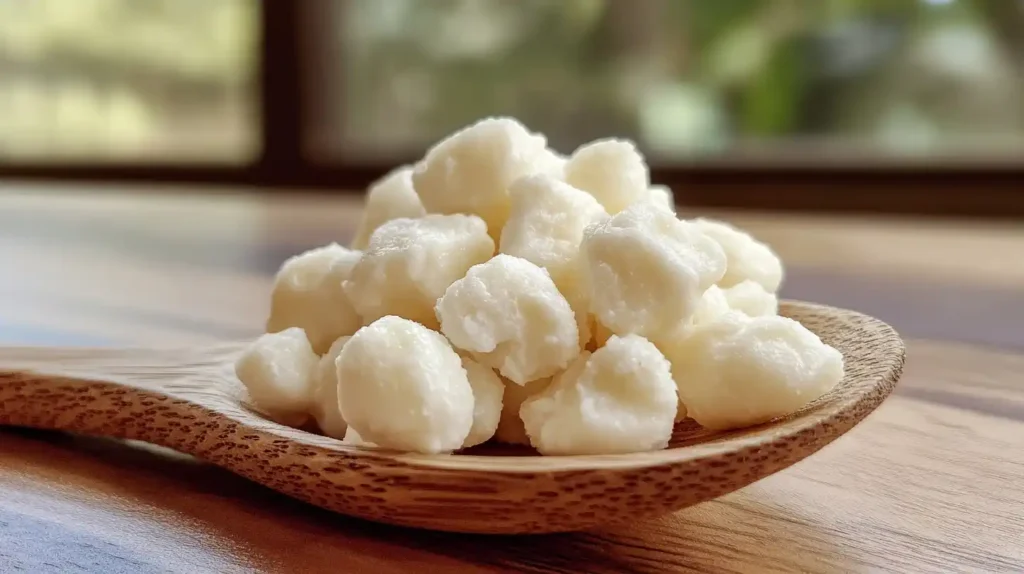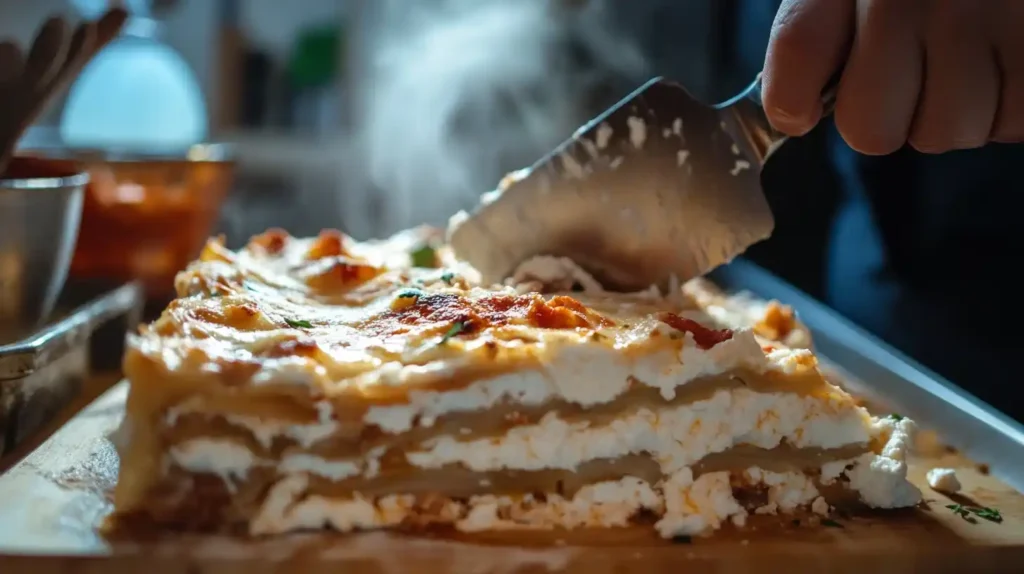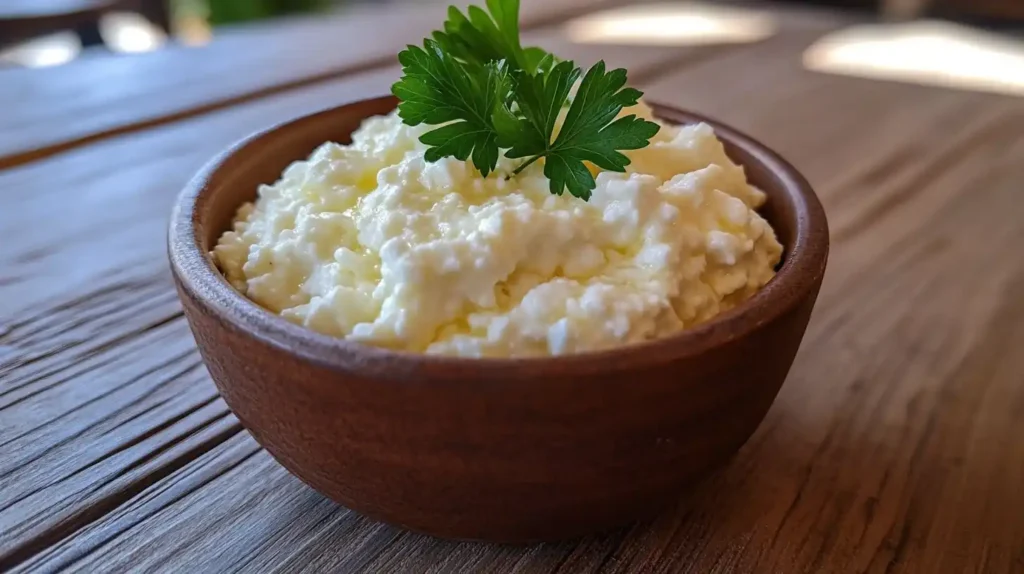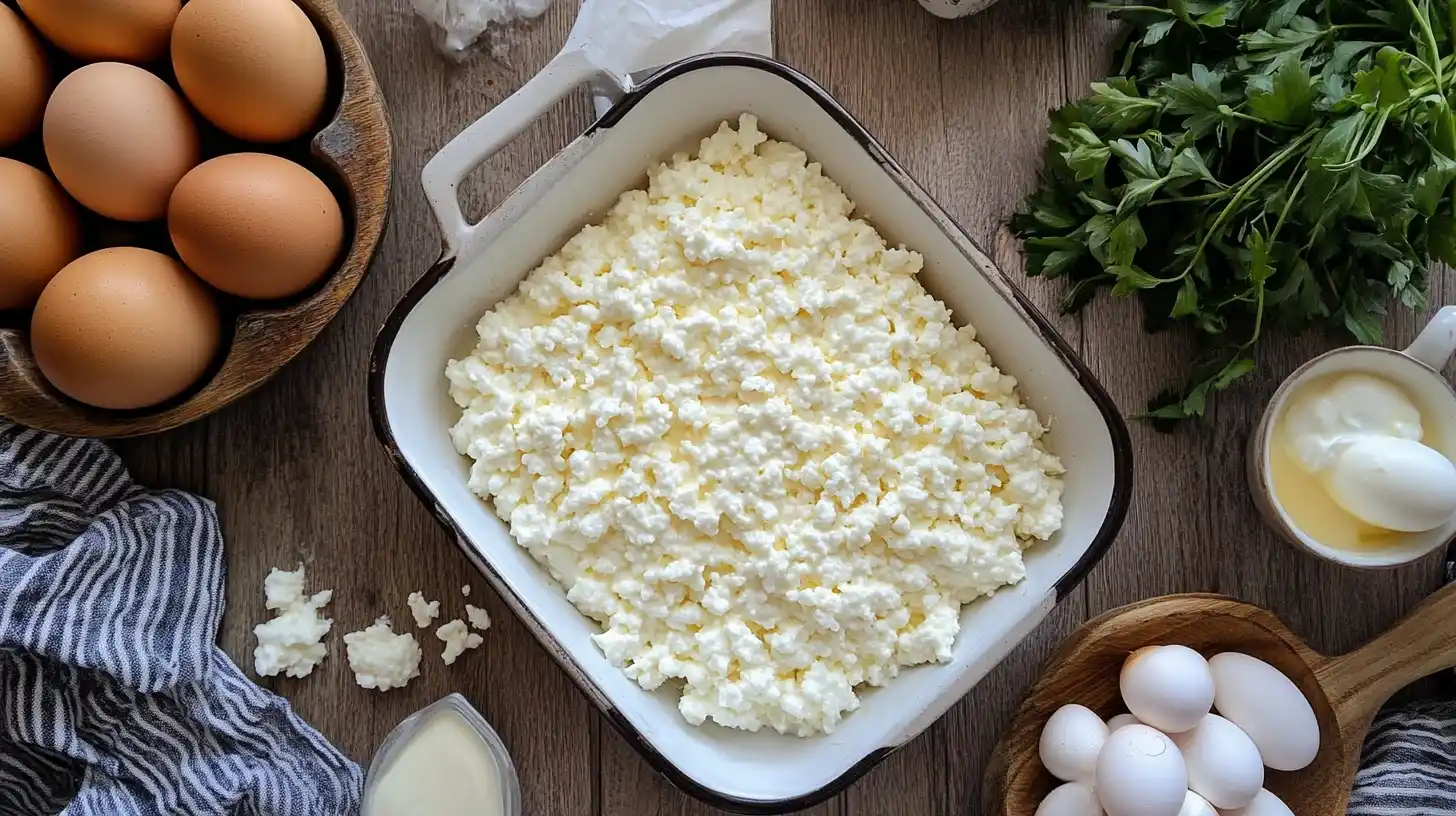If you’ve ever asked yourself, does cottage cheese melt when baked, you’re not alone. Cottage cheese is a widely used ingredient in many recipes. It’s creamy, nutritious, and versatile, but it doesn’t melt like other cheeses. Understanding why this happens can help you use it effectively in your cooking.
This article will explain why cottage cheese doesn’t melt, how to use it in baked dishes, and tips for making it creamy.

Table of contents
Why Cottage Cheese Doesn’t Melt
Why does cottage cheese melt differently from other cheeses when baked? It’s all about its composition:
- High water content: Cottage cheese has a lot of moisture, which prevents it from breaking down into a liquid state.
- Low fat levels: Unlike melting cheeses like gouda or mozzarella, cottage cheese doesn’t have enough fat to achieve gooeyness.
- Acid coagulation: The process of making cottage cheese creates firm curds that stay intact when heated.
These factors explain why cottage cheese doesn’t behave like traditional melting cheeses.
Why This Matters in Cooking
These traits make cottage cheese unique. While it won’t give you that gooey, stretchy texture, it does offer a creamy taste and light texture when used correctly. For example, it’s perfect in lasagna or baked pasta dishes where creaminess is key, not melting.
Food trends and ingredient innovations often shape the way we cook and enjoy meals. For instance, Who Started the Crookie Trend? explores how a creative dessert hybrid became a viral sensation. Just like the crookie brought a fresh twist to sweets, cottage cheese continues to surprise people with its versatility in both savory and sweet dishes.
What Happens When You Bake Cottage Cheese?
When baked, cottage cheese:
- Softens but doesn’t lose its curd-like texture.
- Releases moisture, which can affect the consistency of your dish.
- Blends well with other ingredients, creating creamy layers.
What to Expect When Baking Cottage Cheese
- Lumpy texture remains: Cottage cheese doesn’t fully break down when heated. Instead, the curds keep their shape unless blended first.
- Moisture release: Cottage cheese contains a lot of water. During baking, some of this water evaporates, which can affect the overall texture of your dish.
- Creamy results with blending: If you blend cottage cheese before baking, it can create a creamy, smooth layer for dishes like casseroles or lasagna.
Why Cottage Cheese Works Well in Baked Dishes
Even though it doesn’t melt, cottage cheese has its advantages:
- Adds creaminess: When mixed with eggs, cream, or sauces, it can create a rich, creamy texture.
- Mild flavor: Its light, neutral taste pairs well with savory or sweet dishes.
- Healthier option: Cottage cheese is lower in fat and calories compared to many melting cheeses, making it ideal for lighter meals.
Pro Tips for Baking With Cottage Cheese
- Combine it with melting cheeses, like mozzarella or gouda, for added texture.
- Bake at lower temperatures to prevent water separation or drying out.
- Blend it before use for a smoother, creamier result.
How to Use Cottage Cheese in Baking
Even though cottage cheese doesn’t melt, it’s still a fantastic ingredient in many baked dishes. With the right techniques, you can create creamy, delicious recipes that take advantage of its unique qualities. Let’s look at how to get the best results when baking with cottage cheese.

1. Blend for a Smoother Texture
One simple trick is to blend cottage cheese before using it. A blender or food processor will turn it into a creamy consistency. This is great for:
- Cheesecakes: Blended cottage cheese can replace cream cheese for a lighter dessert.
- Lasagna layers: Use it as a smooth alternative to ricotta.
- Sauces and dips: Blend with herbs or spices for a creamy, flavorful mix.
2. Mix It With Melting Cheeses
Pairing cottage cheese with a cheese that melts well is a great way to balance textures. Try combining it with:
- Mozzarella for stretchy, gooey results.
- Gouda for a creamy and flavorful boost.
- Parmesan for extra savory taste.
This combination works perfectly in baked ziti, casseroles, or stuffed pasta shells.
3. Bake at Lower Temperatures
Cottage cheese has high water content, so baking at high heat can make it dry or separate. Instead:
- Bake at 350°F or lower to keep the moisture in.
- Combine it with eggs or sauces to prevent it from drying out.
Why Cottage Cheese Works Well in Baked Recipes
- Creaminess without melting: Its unique texture adds richness without being overwhelming.
- Versatility: It works in both savory and sweet dishes.
- Health benefits: Cottage cheese is high in protein and low in fat, making it a healthier choice.
Best Baked Dishes with Cottage Cheese
Cottage cheese is a star ingredient in many baked recipes. It adds creaminess and a light texture, making it a versatile choice for both sweet and savory dishes. Here are some of the best ways to use cottage cheese in baking.

1. Cottage Cheese Lasagna
This classic dish swaps ricotta for cottage cheese to create a lighter, creamier texture. Here’s why it works:
- Blended cottage cheese layers well with pasta.
- Adds a mild flavor that complements sauces.
- Healthier than ricotta, with fewer calories and more protein.
To enhance the dish, mix cottage cheese with mozzarella and parmesan for a cheesy, gooey finish.
2. Baked Ziti or Casseroles
Cottage cheese shines in baked casseroles. It’s easy to mix into pasta and provides a creamy base. For example:
- Blend cottage cheese with eggs for a smooth binding layer.
- Add melting cheeses on top for extra texture and flavor.
- Bake at 350°F to avoid water separation.
3. Cheesecake
For dessert lovers, cottage cheese can transform cheesecakes into a lighter, healthier treat. Use blended cottage cheese to:
- Replace cream cheese for fewer calories.
- Create a creamy, smooth batter.
- Add subtle flavor that pairs well with fruits or chocolate.
4. Breakfast Casseroles
Cottage cheese is also great for breakfast bakes. Try it in:
- Egg and veggie casseroles.
- Cottage cheese pancakes for a protein-packed option.
- Muffins or scones to add moistness without excess fat.
Pro Tips for Success
- Always blend cottage cheese for recipes requiring a smooth texture.
- Combine it with melting cheeses or eggs for creamier results.
- Use fresh cottage cheese for the best flavor and texture.
Does Cottage Cheese Melt in the Microwave?
If you’ve ever tried heating cottage cheese in the microwave, you may have noticed that it doesn’t behave like other cheeses. It softens, but it won’t melt into a gooey, stretchy consistency. Let’s explore why and how you can microwave cottage cheese effectively.
What Happens When You Microwave Cottage Cheese?
Unlike mozzarella or cheddar, cottage cheese:
- Softens slightly: The heat breaks down some of the curds, making them less firm.
- Releases moisture: The high water content causes some liquid to separate, creating a watery layer.
- Retains its texture: Cottage cheese doesn’t melt or turn gooey, even under high heat.
Best Ways to Microwave Cottage Cheese
Although it won’t melt, you can still use the microwave to warm cottage cheese for certain recipes. Here are some tips:
- Heat it gently: Use medium power settings to avoid overcooking and separating the curds.
- Combine cottage cheese with eggs, cream, or sauces before microwaving for a smoother texture.
- Stir frequently: This helps distribute heat evenly and prevents lumps.
When to Use Microwaved Cottage Cheese
Microwaved cottage cheese works well in:
- Egg-based dishes like scrambles or omelets.
- Savory dips when blended with herbs and spices.
- Quick snacks, warmed and topped with fruit or honey.
Why Cottage Cheese Doesn’t Melt in the Microwave
If you’ve tried heating cottage cheese in the microwave, you might have noticed that it behaves differently from other cheeses. While mozzarella or cheddar melt into gooey, stretchy goodness, cottage cheese remains lumpy and watery. This happens because of its unique structure and composition.
Reasons Cottage Cheese Doesn’t Melt in the Microwave
- High Water Content
- Cottage cheese contains a significant amount of water. When microwaved, this water is released as steam, leaving behind the solid curds.
- Unlike melting cheeses, which use their moisture to create a smooth texture, cottage cheese loses its water without changing its structure.
- Low Fat Levels
- Melting cheeses, like cheddar or gouda, have high fat content, which allows their proteins to break down and flow when heated.
- Cottage cheese has much less fat, so it lacks the necessary creaminess for melting.
- Acid Coagulation
- Cottage cheese is made using acid to coagulate milk, creating firm curds. These curds are more stable under heat and do not dissolve like cheeses made with rennet.
What Happens When You Microwave Cottage Cheese?
When microwaving cottage cheese, expect the following:
- Softening: The curds become softer but do not fully melt.
- Moisture Release: Water separates from the curds, creating a watery layer.
- No Gooey Texture: Unlike melting cheeses, the curds stay intact and don’t flow.
Tips for Microwaving Cottage Cheese
While it won’t melt, you can use these tips to get the best results:
- Mix with Other Ingredients: Blend cottage cheese with eggs, cream, or sauces before microwaving for a smoother texture.
- Stir Frequently: Stop and stir every 30 seconds to distribute heat evenly.
- Use Medium Power: Avoid high heat to prevent overcooking and excessive water release.
Why This Matters in Cooking
Understanding why cottage cheese doesn’t melt helps you use it effectively. While it won’t replace gooey cheeses in dishes like pizza, it’s still a great choice for adding creaminess to scrambled eggs, casseroles, or quick snacks.
FAQs About Cottage Cheese
Cottage cheese is a versatile and healthy ingredient, but its unique characteristics often raise questions. Let’s address some of the most common queries about cottage cheese and its use in cooking and baking.
Can You Make Cottage Cheese Creamy Without Blending?
Yes, you can! Here’s how:
- Add cream or milk: Gently stir in a small amount of cream or milk to soften the curds and create a smoother texture.
- Heat gently: Warming it slowly over low heat can help break down some of the curds without blending.
- Mix with other ingredients: Combining it with sauces or eggs can mask the lumps and create a creamy consistency.
What Cheeses Work Well With Cottage Cheese?
Cottage cheese pairs beautifully with cheeses that melt well. Some top choices include:
- Mozzarella: For a stretchy, gooey texture in baked dishes.
- Gouda: Adds a mild, creamy flavor to casseroles.
- Parmesan: Perfect for savory toppings with extra flavor.
Mixing these cheeses with cottage cheese creates a balance of creaminess and meltiness in your recipes.
Does Baking Cottage Cheese Change Its Nutritional Value?
Cooking or baking cottage cheese can slightly alter its nutrients. For example:
- Protein remains intact: Heating doesn’t destroy the high protein content of cottage cheese.
- Some nutrient loss: Minimal loss of vitamins like B12 or riboflavin may occur with prolonged heat.
- Healthier alternative: Despite slight changes, it remains a low-fat, high-protein option.
Why Does Cottage Cheese Stay Lumpy?
Cottage cheese is made using acid to create curds. These curds hold their shape, even when heated, unlike rennet-based cheeses.
What is the ideal method for incorporating cottage cheese into baking?
For the best results:
- Blend it for smooth recipes like cheesecakes or sauces.
- Pair it with melting cheeses in lasagna or casseroles.
- Bake at lower temperatures to avoid drying out or water separation.
Conclusion and Key Takeaways
So, does cottage cheese melt when baked? The answer is no, but that doesn’t mean it’s not useful in the kitchen. Cottage cheese brings unique qualities to many recipes, adding creaminess, protein, and a light texture without the need to melt. Whether you’re making a savory casserole or a sweet cheesecake, cottage cheese can be a healthy and versatile choice.
Key Points to Remember
- Why Cottage Cheese Doesn’t Melt: Its high water content, low fat levels, and acid coagulation process prevent it from becoming gooey like other cheeses.
- How It Behaves When Baked: Cottage cheese softens, releases moisture, and blends well with other ingredients but retains its curd-like texture unless blended.
- Tips for Baking: Blend it for smooth textures, combine it with melting cheeses, and bake at lower temperatures for best results.
- Best Recipes: Use cottage cheese in lasagna, baked pasta, cheesecakes, or breakfast casseroles to enjoy its creamy qualities.
Final Thoughts
To answer the question does cottage cheese melt when baked, the simple answer is no. But that doesn’t stop it from being a versatile and delicious ingredient. Its creamy, protein-rich qualities make it a fantastic addition to baked dishes, whether savory or sweet.

